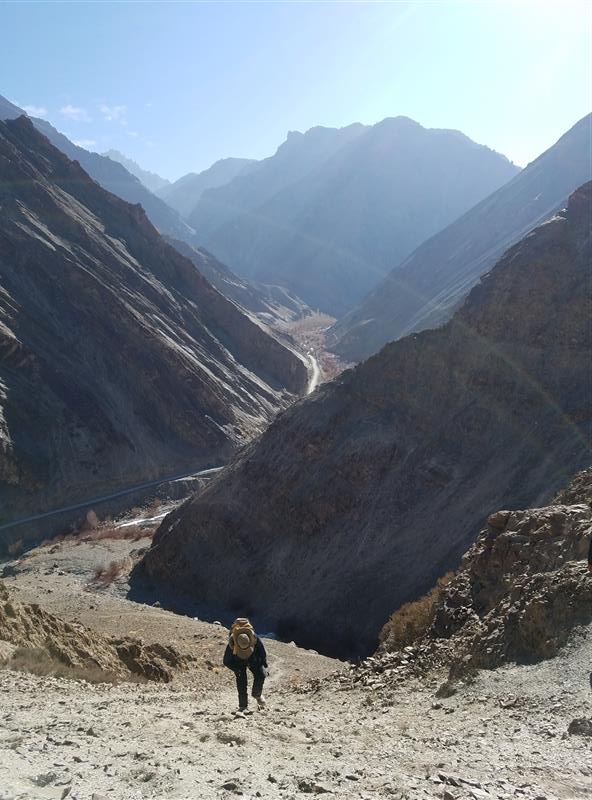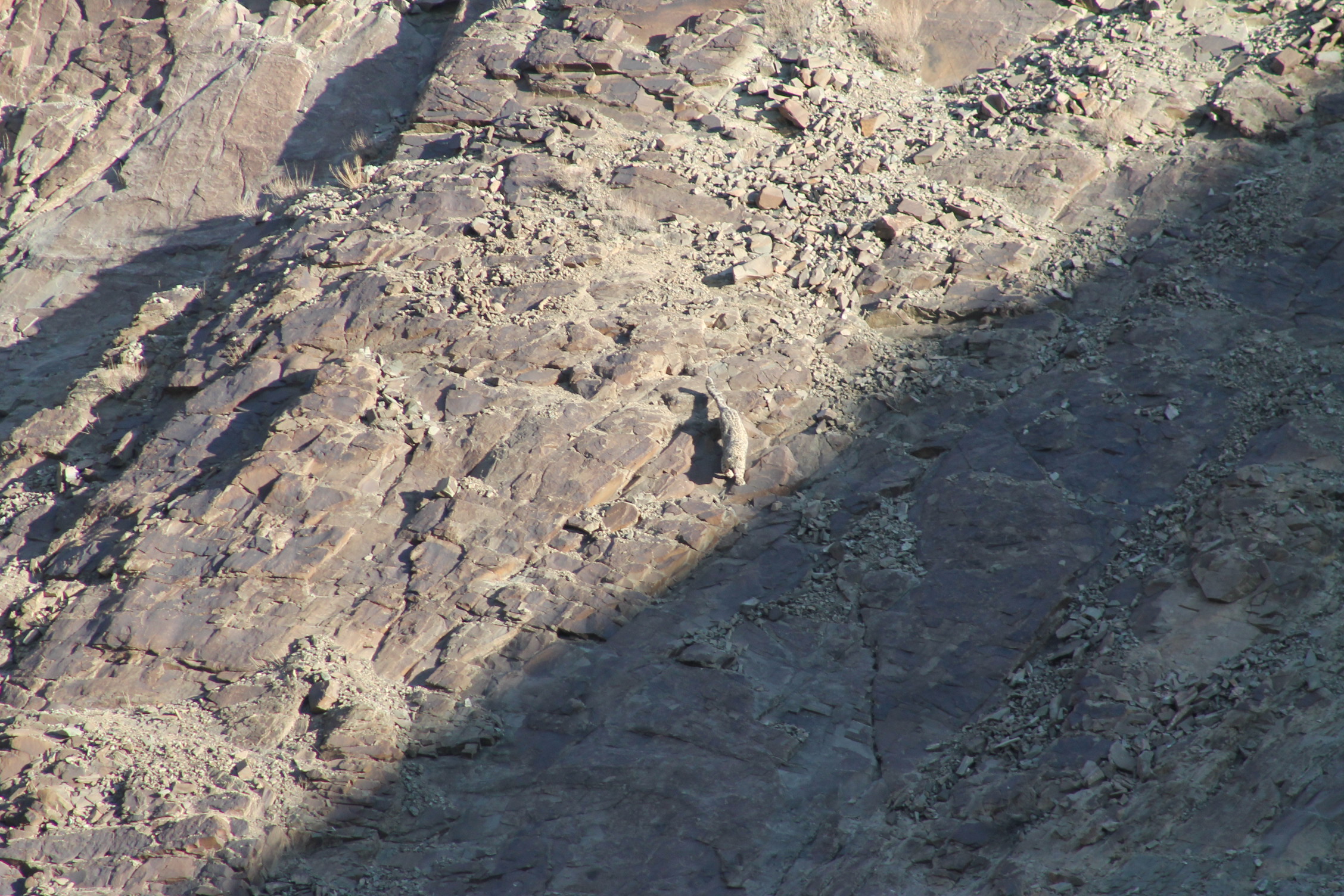Chasing Big Cats: Snow Leopards and Perseverance
I’ve always been nervous about meeting new people. Socializing is not my natural state. I hated Santa--coming into our grandparents’ house, demanding me to sit on his lap. I’d run and hide under the dining room table when I heard that jolly ho-ho-ho. My stomach does flops thinking, not about the presentation to 300 people, but of the awkward mingling with conference attendees and fellow speakers before and after. I avoid parties where I don’t know at least three people closely (I gladly host them, happy in the knowledge I can always escape into hosting duties such as serving food or MCing a game). Spending three weeks on a frigid Indian mountainside in December with a handful of strangers who mostly speak languages other than my own was quite possibly the scariest thing I’ve ever attempted.
This post is about leaving your comfort zone. A critical element of personal development—and more importantly, of becoming the best designer you can possibly be.
That morning arriving to Leh, after thirty hours of travel and four flights, I was not ready to sit and drink tea with five strangers—in a country I’ve never been. We made small talk about how the flights were and where we are from. We weren’t sure what kind of tea to drink. What is Masala? Is it with goat’s milk like my friend warned me of? How much caffeine does it have? Do I need sugar??? I didn’t know who actually spoke English and therefore could handle me asking them a question, and who would look at me panicked not understanding what the tall blonde American lady is demanding! I was tired, cranky, but also excited to finally be here. To finally be on the hunt for the elusive snow leopard.
Several days later, after “adjusting” to the elevation of Leh (around 11,000’) and after spending a day together birding around the Himalayan foothills surrounding the town, we loaded up the SUV with our gear to hit the mountains. We headed to our camp in Hozing Valley. Situated among mountain ridges between 12,000 and 13,000’, our base camp consisted of three small sleeping tents (one for each of us), and two larger mess-style canvas tents—one serving as kitchen, one as the dining room. The dining tent had a propane heater; the kitchen had a cook and a cook’s assistant. We had a simple pit-toilet outhouse—a hole in the floor. We had no running water, no heat in our sleeping tents. It was December, and it was cold. Very cold. The coldest night was about -35 F.
The days were filled with hiking nearly vertical slopes among boulders and on gravelly sheep-made paths, to sit in the sun on ridges overlooking the valley. We’d sit for hours, scanning the rocky cliffs with binoculars and spotting scopes. We’d layer up for the frigid morning walks starting at sun up—before the sun passed over the ridges, when accidental water spills turned instantly into icicles. Some mornings--the coldest mornings, I’d be wrapped up so thick, my shadow looked like an astronaut: two wool base layers, two pairs of snow pants on my legs; a wicking shirt, two wool base layers, a fleece vest, a fleece jacket, a down jacket, and a ski jacket on top; a scarf; two hats (one a beanie, and one a thick, (faux) fur-lined Nordic thing); three pairs of socks; a pair of wool gloves beneath a thick set of mittens. At 10:30am, the sun came up over the ridge--its warmth allowed us to remove layers, and caused our feet to sweat as we trekked up several hundred feet of steep slope in astronaut gear. Then, when the sun found its way behind the ridges again at 3:30pm, our toes began to numb as our sweat-soaked socks and boots literally froze.
It was fun. I definitely lost 5 pounds.
But the reward was delivered on the third day: a snow leopard! The build-up to the sighting was screenplay perfection. Our trackers spotted a blue sheep (the snow leopard’s favorite prey), dead on the ridge above our camp. They inspected the frozen carcass and found no obvious signs of trauma, just a dribble of blood at the corner of his mouth. Certainly within the realm of possibility of a snow leopard kill. Later, a local reported snow leopard tracks on the road leading to our camp. Trackers dispersed across the valley, scanning the rocky ledges and cliffs with spotting scopes. We sat quietly scanning, until one of the trackers came running down a steep hillside, and delivered the news: a snow leopard.
His (we assumed he was a male, although no one could confirm) kill was located just 150 yards from our camp—a very, very lucky chance occurrence. We watched him for four days, as he stayed to feed on the frozen carcass, fully within view. During that time, we watched patiently as he slept in the sun. And slept in the sun. And slept in the shade! And slept in the sun. Someone always had their eye on the lens, watching. And when he shifted position, we’d yell, “Head up!” and everyone ran to the scopes. He stretched like a housecat, and curled his long tail around him, using it as a pillow. We’d squeal and coo, like children. We’d celebrate every evening with a toast of cheap brandy, before heading to bed at 8pm. We became compatriots in battle, bound by one, big, fluffy kitty cat.
The trip was 12 days in the Himalayas, split between two locales. We stayed at our tented camp for eight, adjusting the itinerary due to seeing the leopard. We also stayed at a homestay for the balance, where the accommodations were slightly more luxurious, but still with limited heat, and no indoor plumbing. At the end of the trip, we said good-bye to the local guides and staff (five of them), and the couple from Spain (who were the only paying tourists other than me) departed. My tour guide, Marta, and I headed onto Talla and Bandhavgarh to search for tigers. The accommodations there were absolutely luxurious with toilets and showers, a real bed, and a space heater. And the climate was balmy at 55-65 F. We had an amazing day and a half exploring Bandhavgarh Tiger Preserve, where 65 tigers reside in 172 square miles. Chances of seeing tigers is slightly better than seeing snow leopards in Leh, yet we saw only one, and only for five minutes.
Even so, my trip was blessed with wildlife. Everyone we talked to spoke of how lucky we were. Most people see a snow leopard on our itinerary, but they are usually much, much further away, and for only a few minutes. We saw two (the second was just a brief interlude—a more typical tourist experience), and we saw a tiger.
I like to think this luck was a reward for my bravery. For not cancelling the trip when I couldn’t find a travel partner. For not chickening out--knowing that I get cold very easily and don’t like curry (especially now!). And it reminds me that good things generally come from sticking your neck out.
For many years, my annual reviews at PGAV consistently pointed to one major downfall of my performance: not being assertive enough. I realized in India—as I pondered if I really knew how to identify frostbite—that I had become quite assertive. I ‘stopped asking for permission, and started asking for forgiveness.’ And many times I failed, but many more times, I didn’t. It was more than not failing. It was succeeding. Taking chances and not waiting for the “perfect time” has changed my trajectory in my professional life. I always think about design from the options that we haven’t yet tried. I explore the crazy ideas that seem, on first glance, unrealistic. I don’t back away just because there is a potential negative—because there might also be a bigger positive you don’t yet see. However, it doesn’t mean we waste time going in never-ending circles. I’ve become strong enough and brave enough to make decisions based on logic, reasoning, and a little gut—and run with them.
And you should too. Step out into the cold, or into a room full of strangers, every once in a while. Speak up. Take action. Take a chance… and maybe you, too, will be blessed with big cats.














